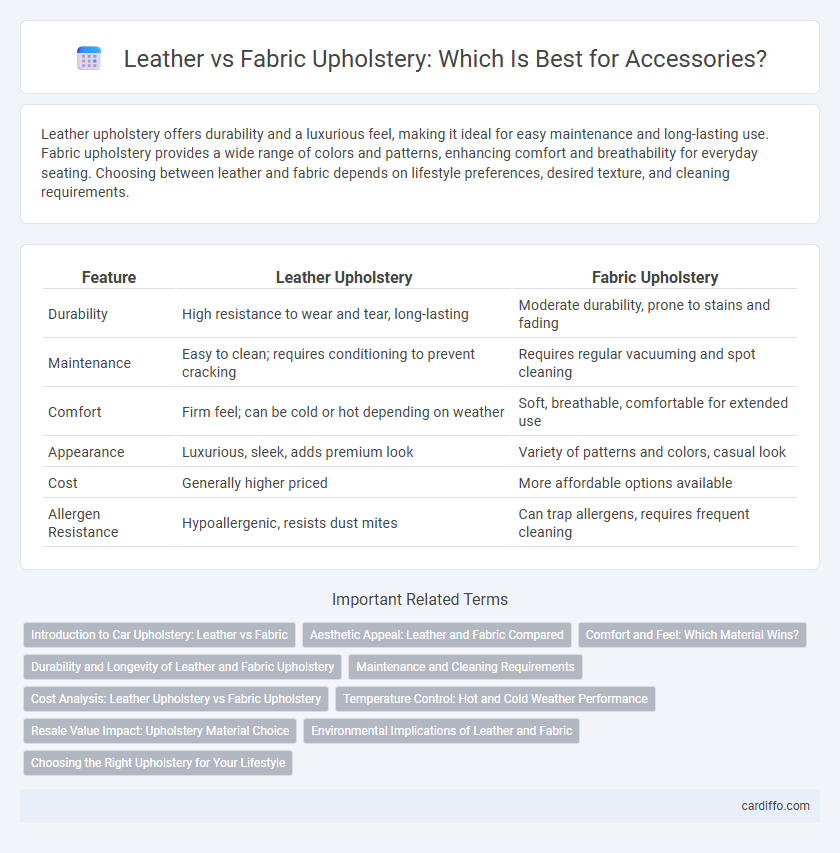Leather upholstery offers durability and a luxurious feel, making it ideal for easy maintenance and long-lasting use. Fabric upholstery provides a wide range of colors and patterns, enhancing comfort and breathability for everyday seating. Choosing between leather and fabric depends on lifestyle preferences, desired texture, and cleaning requirements.
Table of Comparison
| Feature | Leather Upholstery | Fabric Upholstery |
|---|---|---|
| Durability | High resistance to wear and tear, long-lasting | Moderate durability, prone to stains and fading |
| Maintenance | Easy to clean; requires conditioning to prevent cracking | Requires regular vacuuming and spot cleaning |
| Comfort | Firm feel; can be cold or hot depending on weather | Soft, breathable, comfortable for extended use |
| Appearance | Luxurious, sleek, adds premium look | Variety of patterns and colors, casual look |
| Cost | Generally higher priced | More affordable options available |
| Allergen Resistance | Hypoallergenic, resists dust mites | Can trap allergens, requires frequent cleaning |
Introduction to Car Upholstery: Leather vs Fabric
Leather upholstery offers a luxurious, durable, and easy-to-clean surface ideal for high-end vehicles, while fabric upholstery provides a breathable, comfortable, and more affordable option with a wide range of colors and patterns. Leather tends to resist stains and odors better but can be prone to cracking and requires regular maintenance to preserve its appearance. Fabric upholstery excels in temperature regulation and is less slippery, making it a practical choice for varying climates and long-term comfort.
Aesthetic Appeal: Leather and Fabric Compared
Leather upholstery offers a sleek, luxurious aesthetic with a polished finish that ages gracefully, developing a rich patina over time. Fabric upholstery provides a versatile range of colors, patterns, and textures that can complement diverse interior styles and create a cozy, inviting atmosphere. The choice between leather and fabric largely depends on desired visual impact and the ambiance intended for the space.
Comfort and Feel: Which Material Wins?
Leather upholstery offers a smooth, luxurious feel that adjusts to body temperature, providing a cool touch in summer and warmth in winter. Fabric upholstery excels in softness and breathability, enhancing comfort with its natural texture and moisture-wicking properties. Comfort ultimately depends on personal preference, with leather favored for durability and sleekness, while fabric is preferred for cushioning and warmth.
Durability and Longevity of Leather and Fabric Upholstery
Leather upholstery offers superior durability and longevity due to its natural resistance to wear, tears, and stains, making it ideal for high-traffic areas. Fabric upholstery varies widely in durability depending on the material, with tightly woven synthetic fibers generally providing better resistance to fading and abrasion than natural fibers. Over time, leather develops a patina that enhances its appearance, while fabric may require more frequent replacement or professional cleaning to maintain its aesthetic quality.
Maintenance and Cleaning Requirements
Leather upholstery requires regular conditioning to prevent cracking and is resistant to stains, making it easier to clean with just a damp cloth and mild soap. Fabric upholstery demands frequent vacuuming and spot treatment to avoid stains and odor buildup, often needing professional cleaning for deep maintenance. Both materials benefit from prompt spill cleanup, but leather's non-porous surface generally reduces long-term maintenance efforts compared to fabric.
Cost Analysis: Leather Upholstery vs Fabric Upholstery
Leather upholstery generally incurs higher upfront costs compared to fabric upholstery due to the price of premium hides and more complex manufacturing processes. Maintenance expenses for leather can be lower over time as it resists stains and is easier to clean, while fabric upholstery may require frequent cleaning or replacement, increasing long-term costs. Budget-conscious consumers often weigh initial investment against durability and upkeep, with leather offering a more expensive but longer-lasting option relative to fabric.
Temperature Control: Hot and Cold Weather Performance
Leather upholstery excels in temperature regulation by remaining cool in hot weather but can become uncomfortably cold during winter months. Fabric upholstery offers better breathability and insulation, providing more consistent comfort across both hot and cold conditions. Choosing between leather and fabric depends on climate priorities and personal temperature sensitivity.
Resale Value Impact: Upholstery Material Choice
Leather upholstery often enhances the resale value of furniture and vehicles due to its durability, timeless appeal, and ease of maintenance compared to fabric. Fabric upholstery, while offering a wide range of colors and patterns, may show wear and stains more readily, potentially lowering its resale desirability. Choosing leather over fabric can be a strategic investment that preserves and even increases the item's market value over time.
Environmental Implications of Leather and Fabric
Leather upholstery involves animal agriculture, contributing to higher greenhouse gas emissions, deforestation, and water consumption compared to fabric upholstery, which often uses synthetic fibers derived from petrochemicals. However, some natural fabric options like organic cotton or hemp have lower environmental footprints, utilizing renewable resources and biodegradable materials. Choosing upholstery materials with sustainable certifications or recycled content significantly reduces environmental impacts related to production and disposal.
Choosing the Right Upholstery for Your Lifestyle
Leather upholstery offers durability, easy cleaning, and a sleek appearance, making it ideal for high-traffic areas and pet-friendly homes. Fabric upholstery provides greater comfort, a wider range of colors and patterns, and better breathability, well-suited for cozy living spaces and families with sensitive skin or allergies. Selecting the right upholstery depends on your lifestyle needs, including maintenance preferences, household activity levels, and aesthetic goals.
Leather Upholstery vs Fabric Upholstery Infographic

 cardiffo.com
cardiffo.com